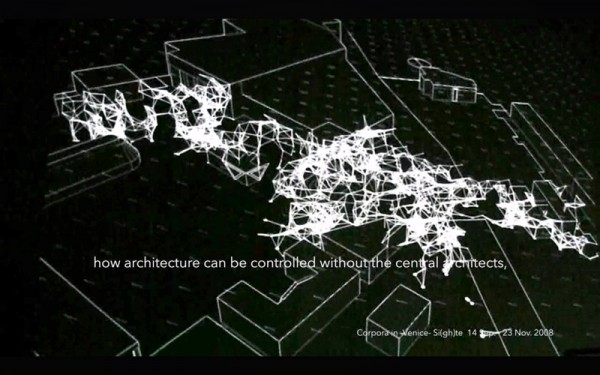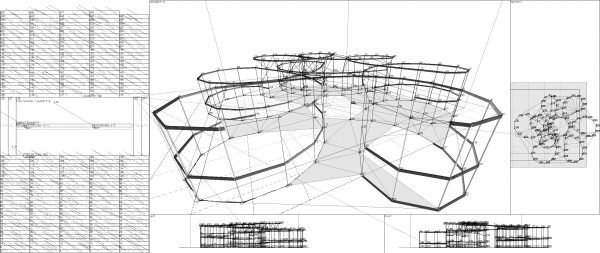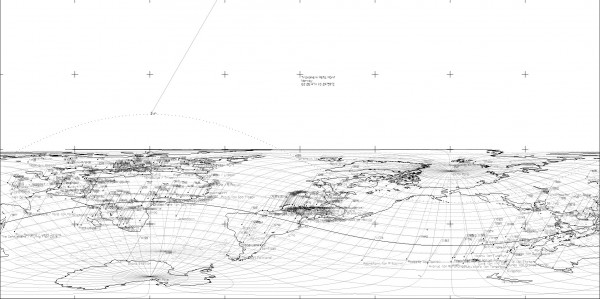Corpora In Si(gh)te
Corpora in Si(gh)te
Corpora in Si(gh)te is a generative architecture installation based on real-time processing of environmental data.
It is questioning of how architecture can be controlled without the central architects, how architecture can interact with the surrounding environment, how architecture can be redesigned by itself, how we can develop new concepts with a unique notation system.
A number of sensors are setup forming a mesh network throughout the target area in order to collect and distribute real-time environmental information such as temperature, brightness, loudness, humidity, wind direction and wind speed. This sensor network can be seen as the nervous system of the virtual structure. The data collected from these sources are processed by a software and translated into autonomous nodes which we call “Super Eyes”. These “Super Eyes” are the seeds for the virtual architecture of “Corpora” representing a cellular, distributed network of nodes that are reacting through real-time processing, growing and subsiding like an organism. Each “Super Eye” collects environmental data from the closest sensor and makes local decisions independently of a central architect. The “Super Eyes” inadvertently give rise to an architectural structure, both surrounding the exhibition building and neighborhoods. This “information architecture” of “Super Eyes” has its own spatial perception to make itself transform into various forms by relying on the “Super Eyes” spatial notation concept. The fluid character of this architecture occurs as a living form. Visitors can observe this process by Augmented Reality Technology through cameras located in the target site.
While living within a given set of linguistic conventions it’s hard to think outside of that language. Such concepts may seem to not come out immediately in the resulting design. It could be as simple as a question of different tools. Different tools will affect what can be created. Computer software for design has different characteristics, and these help determine what’s easy or difficult to create.
But these elements are creators’ concerns. What about the broader questions of how to understand objects, how to grasp the world. This again can be language dependent. And it is not a question limited to creators. The question of an architect’s language and creation can be stated by paraphrasing Wittgenstein: “Do the limits of the architect’s language determine the limits of architecture?
Equipment cooperation: Yamaguchi Center for Arts and Media [YCAM]
Created by doubleNegatives Architecture
doubleNegatives Architecture
doubleNegatives Architecture (dNA) views metaphorical machines used to measure space as”architecture”. They engage activities including interactive installations, software tool development and architectural design. dNA’s work started from a motivation to focus attention on this spatial notation = language, developing new forms notation itself, to obtain particular design perspectives. This evolved their major project “Corpora”.
Core members of the project “Corpora”:
Max Rheiner, Ákos Maróy, Kaoru Kobata and Sota Ichikawa.
selected exhibitions:
2014 《MU: Mercurial Unfolding Collaboration with Fujiko Nakaya》 (4th APAP), Anyang, Korea
2014 《understanding》(Arata Isozaki SOLARIS) NTT InterCommunication Center, Tokyo, Japan
2013 《House in Nagohara》(Materializing) Chinretsukan Gallery The University Art MUSEUM, Tokyo, Japan
2012 《Corpora.Condensation》(Open Space 2012) NTT InterCommunication Center, Tokyo, Japan
2012 《Super Eye to See the World》(Mediacity Seoul 2012)Seoul Museum of Art, Seoul, Korea
2011 《Corporate Eyes》(Beyond the Naked Eye) Tokyo Metropolitan Museum of Photography, Tokyo, Japan
2010 《Corpora.Prospect》(Lexus Hibrid Art)Vetoshnyy, Moscow, Russia
2010 《Corpora in Si(gh)te》(Ars Electronica in Mexico), Laboratorio Arte Alameda,Mexico Sity, Mexico
2009 《MU: Mercurial Unfolding Collaboration with Fujiko Nakaya》Institut francais du Japon、Tokyo, Japan
2009 《Corpora.Prospect》(Mission G) NTT InterCommunication Center, Tokyo, Japan
2009 《Corpora in Si(gh)te》(ARS electronica.09) OK center, Linz, Austria
2009 《Corpora in Si(gh)te》(transmediale.09) .CHB, Berlin, Germany
2008 《Corpora in Si(gh)te》(11th Venice Architectural Biennale, Hungarian Pavilion solo exhibition) Hungarian Pavilion Giardini park, Venice, Italy
From left: Sota Ichikawa(JP), Kaoru Kobata(JP), Max Rheiner(CH), Ákos Maróy (HU)
http://www.ntticc.or.jp/Archive/2005/Opennature/Works/corporaproceed.html







